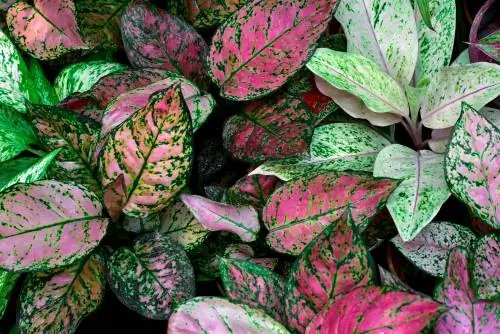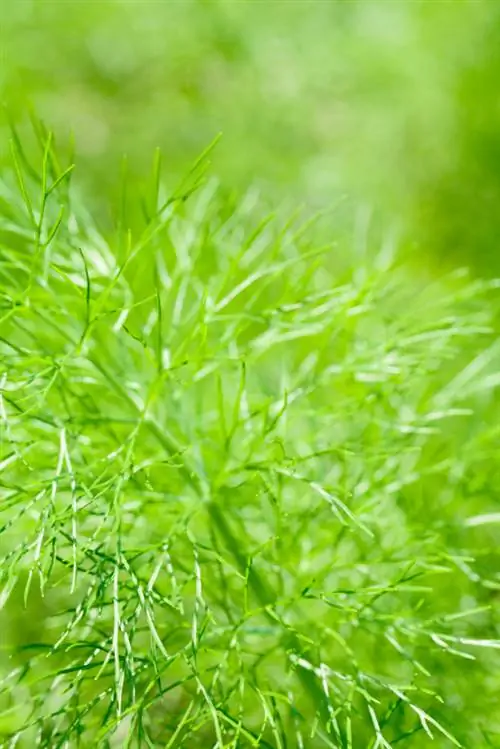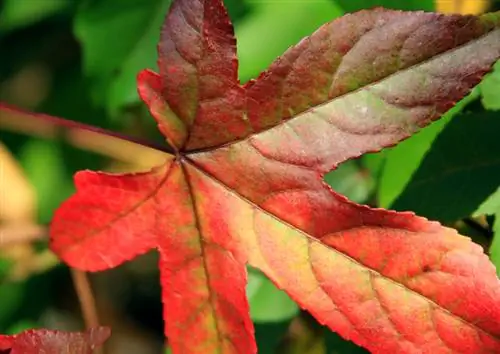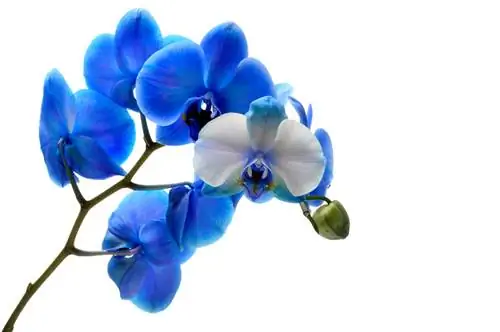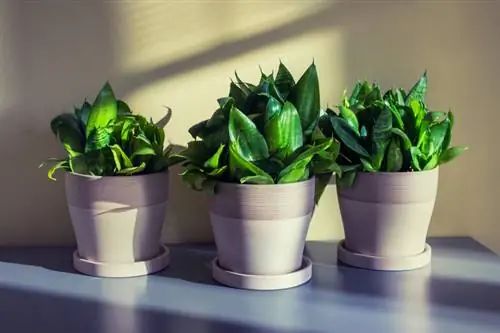- Author admin [email protected].
- Public 2023-12-16 16:46.
- Last modified 2025-01-23 11:21.
The piston thread (bot. Aglaonema) belongs to the plant genus of the same name from the plant family of the Araceae (bot. Araceae). The botanical name refers to the shiny stamens of the genus, as it is made up of the ancient Greek words for “glorious” (agláos) and “thread” (néma). The cob thread is a popular houseplant, as it also thrives in shady locations and has beautifully marked, large leaves.

What are the ideal conditions for a piston thread?
The Aglaonema is a tropical houseplant with attractive, large, structured leaves. It prefers partially shaded to shady locations, high humidity, temperatures between 18 and 25 degrees Celsius and regular watering and fertilization cycles.
Origin and Use
We mainly cultivate the species Aglaonema commutatum as a houseplant, which is native to the tropical forests of the Indonesian island of Sulawesi and the Philippines. In the tropical countries of Asia, the distinctive foliage plant is also often planted in parks and gardens, but in our country it can only be used as a houseplant due to the unsuitable weather.
Appearance and growth
The evergreen cob thread grows bushy as a subshrub. It forms upright stems that can reach heights of between 40 and 50 centimeters. Over the years, the entire plant, including the leaf mass, can reach heights of up to one meter and the same width. Of course, such specimens require a lot of space. As a houseplant, the cob filament rarely flowers and almost never produces fruit.
leaves
The alternately arranged and broadly lanceolate leaves of the cob filament can be up to 30 centimeters long. Depending on the variety, they are also rather wide or narrow. However, the plant is particularly attractive because of the particularly attractive grain of its leaves: The mostly silvery-white markings vary in intensity in the different cultivated forms: While some varieties only have light lines on medium to dark green leaves, others are almost exclusively silver-colored with few green shares. The large leaves of the cob filament are also said to improve the indoor climate and have an air-purifying effect.
Flowers and flowering time
The inflorescences of the cob filament only appear rarely in indoor cultivation and often only after many years. They are characteristic of arum plants, to which the genus belongs botanically, and are composed of a greenish bract - the so-called spathe - and the white spadix. However, compared to the strikingly patterned leaves, the flowers are quite inconspicuous. The typical flowering period is between June and September.
Fruits
In the natural habitat, conspicuous red berries develop on the cob from the monoecious, separate-sex inflorescences. However, this only happens very rarely in indoor culture due to the lack of fertilization.
Toxicity
Like all arum plants, the cob filament is poisonous and should therefore only be cultivated out of the reach of children and pets. All parts of the plant contain saponins and small amounts of hydrogen cyanide, and plant sap that escapes can cause skin irritation.
Which location is suitable?
The popularity of the cob filament as a houseplant results not only from the attractive leaf coloring, but also from the fact that the plant copes very well with comparatively little light. For this reason, the species also decorates darker corners of rooms, but needs high humidity of more than 60 percent and a lot of warmth all year round. During the summer months, the ambient temperature for the piston thread is at least 20 degrees Celsius, but in winter it must not be cooler than 18 degrees Celsius. For these reasons, a partially shaded to shady location in the bathroom (but only in those with a window!) or in a heated winter garden is perfect. Place the cob thread in a place with plenty of space - the plant appreciates a free stand. In addition, if possible, the plant should not be moved once a suitable location has been found.
Substrate
Cultivate the cob thread either hydroponically or in soil culture in a loose, well-drained and humus-rich container plant soil. Make sure that it does not contain any peat.
Planting and repotting
When potting the ornamental leaf plant, make sure that the plant pot is not too large. In any case, the cob thread grows very slowly, so that it will only be necessary to move it to a larger container every two to three years. Good pot drainage is also important to avoid waterlogging:
- Drainage hole at the bottom of the pot
- Cover the drain hole with potsherds or pebbles
- Mix the substrate with fillers such as clay granules or similar
- Empty the planter or saucer after watering
Repotting is best done in spring, removing the old soil as much as possible. Be sure to leave a watering edge free, this will make watering easier later and prevent water from spilling over. You can also move the cob thread into fresh substrate every year, then you no longer need to fertilize the plant. A new pot is not always necessary.
As a typical shallow-rooted plant, the cob thread needs a plant pot that is wide rather than deep.
Hydroculture
Alternatively, the cob thread can also be cared for very well in hydroponics, which further reduces the already low maintenance effort. For this purpose, if possible, buy plants that have already been grown hydroponically, as the older the plants, the more difficult it is to convert from soil to hydroponics. Therefore, you should only reacquaint young specimens, and you must completely remove all substrate. The best time for this is before the new spring shoots, i.e. in late winter between February and March.
Pouring piston thread
The soil of the cob thread should be kept evenly slightly moist, but never wet - this inevitably leads to rot. Since the plant, like so many tropical plants, is very sensitive to lime, you should only use low-lime water at room temperature for watering. Stale tap water or soft rain water is ideal. Optimal care also includes regularly spraying the plant with lime-free water. This measure can be omitted during the winter months; you can also significantly reduce watering.
Fertilize cob thread properly
Since the cob thread does not take a real winter break, you should fertilize it all year round. Between April and October, feed the houseplant once a week with a commercially available liquid pot plant fertilizer (€14.00 on Amazon). A variety for green or foliage plants is best suited for this purpose. During the winter months, only care for the plants every two to three weeks.
Cut the piston thread correctly
Pruning measures are basically not necessary, but you can encourage the cob thread to branch more strongly by pruning it correctly. To do this, cut off individual leaf stalks up to just below the lowest eye. Then dust the cuts with charcoal powder to prevent fungi and other pathogens from entering. Be sure to wear gloves and long clothing when cutting the poisonous arum plant, as the plant sap can cause skin irritation and even eczema.
Increase cob thread
If you can't get enough of the pretty foliage plant, you should propagate it. There are three different methods for this, all of which are quite straightforward and quickly lead to plant offspring.
Division
When repotting in spring, you can simply divide large specimens of the cob thread into two or several individual pieces and plant them separately in pots. Every new plant should have at least one bud and three leaves. The subsequent care is the same as for the adult plant - a special culture in an indoor greenhouse or similar is not necessary.
Cuttings
In June you can cut off he althy, strong side shoots and use them as cuttings. These should be around ten to 15 centimeters long and have at least three leaves each. Remove all but the topmost leaves and place the shoots in small pots with nutrient-poor growing substrate. Now keep them warm at least 25 degrees Celsius and always slightly moist in a bright but not directly sunny place. High humidity is also an advantage for rapid rooting, which is why the plants are best kept in a greenhouse or under another translucent cover. In this case, however, do not forget to ventilate daily!
Daughter plants
In older cob filaments, so-called adventitious plants develop during the summer months, which are small daughter plants. Leave them on the mother plant during the autumn and winter months and separate them along with the roots when repotting the following spring. Then plant the young plants separately in pots with fresh, humus-rich substrate.
Wintering
Since the cob filament should be cultivated warm all year round, special measures for overwintering do not make sense.
Diseases and pests
The cob thread is quite insensitive to diseases and pests - provided it is cared for correctly and according to its needs. Wilted leaves, for example, are a clear indication of a lack of water, which can be remedied by watering more frequently. Brown leaf spots and/or curled leaf edges, on the other hand, indicate a lack of humidity (especially if only the tips of the leaves turn brown) or an excess of sunlight. When it comes to pests, spider mites, thrips and aphids are the main ones that cause problems for the cob thread.
Tip
Create a veritable jungle in your living room with a selection of attractive ornamental foliage plants that have similar needs to the bulbous thread. Single leaf, Dieffenbachia, Asplenium or Chamaedorea, for example, are suitable for a communal culture.
Species and varieties
There are 23 different species of plunger, all of which are native to tropical Asia. Aglaonema commutatum, which comes from the Philippines and northeast Sulawesi and is characterized by a large variety of cultivated varieties, is used as an easy-care houseplant. The different varieties of the species differ primarily in their leaf decoration, which can be silver, yellowish, reddish or multicolored. In addition to these, other species such as the smaller, bushy-growing Aglaonema costatum or the particularly beautifully marked Aglaonema crispum are in cultivation.
The most beautiful cob thread varieties
- 'Jubilee': large, two-tone silver-green leaves
- ‘Silver’: large, two-tone silvery-green leaves
- 'Silver Bay': strong bushy growth, predominantly silver-colored leaves with delicate green markings
- 'Silver Queen': silver-colored leaves with light, green stripes
- 'Silver King': predominantly silvery leaves with delicate green markings
- 'Cutlass': particularly narrow, two-tone silvery-grass-green leaves
- 'Key Lime': predominantly dark green, large leaves with pretty lime yellow markings
- 'White Lance': very narrow, predominantly silver-colored leaves with slight green markings
- 'Crete': green leaves with striking purple-red markings
- ‘Stripes’: grass-green to dark green leaves with striking, silvery stripes
- ‘Tricolor’: pink stems, silver-green foliage

